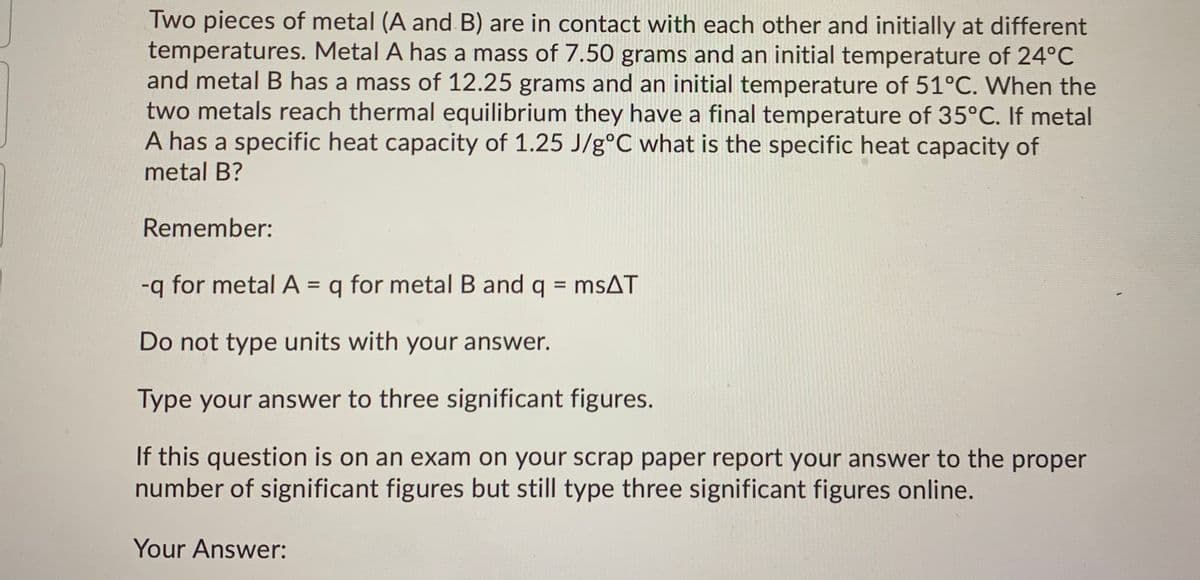Two pieces of metal (A and B) are in contact with each other and initially at different temperatures. Metal A has a mass of 7.50 grams and an initial temperature of 24°C and metal B has a mass of 12.25 grams and an initial temperature of 51°C. When the two metals reach thermal equilibrium they have a final temperature of 35°C. If metal A has a specific heat capacity of 1.25 J/g°C what is the specific heat capacity of metal B?
Two pieces of metal (A and B) are in contact with each other and initially at different temperatures. Metal A has a mass of 7.50 grams and an initial temperature of 24°C and metal B has a mass of 12.25 grams and an initial temperature of 51°C. When the two metals reach thermal equilibrium they have a final temperature of 35°C. If metal A has a specific heat capacity of 1.25 J/g°C what is the specific heat capacity of metal B?
Chemistry: The Molecular Science
5th Edition
ISBN:9781285199047
Author:John W. Moore, Conrad L. Stanitski
Publisher:John W. Moore, Conrad L. Stanitski
Chapter4: Energy And Chemical Reactions
Section4.4: Heat Capacity
Problem 4.3PSP: A piece of aluminum with a mass of 250. g is at an initial temperature of 5.0 C. If 24.1 kJ is...
Related questions
Question

Transcribed Image Text:Two pieces of metal (A and B) are in contact with each other and initially at different
temperatures. Metal A has a mass of 7.50 grams and an initial temperature of 24°C
and metal B has a mass of 12.25 grams and an initial temperature of 51°C. When the
two metals reach thermal equilibrium they have a final temperature of 35°C. If metal
A has a specific heat capacity of 1.25 J/g°C what is the specific heat capacity of
metal B?
Remember:
-q for metal A = q for metal B and q = msAT
%D
%3D
Do not type units with your answer.
Type your answer to three significant figures.
If this question is on an exam on your scrap paper report your answer to the proper
number of significant figures but still type three significant figures online.
Your Answer:
Expert Solution
This question has been solved!
Explore an expertly crafted, step-by-step solution for a thorough understanding of key concepts.
Step by step
Solved in 2 steps

Recommended textbooks for you

Chemistry: The Molecular Science
Chemistry
ISBN:
9781285199047
Author:
John W. Moore, Conrad L. Stanitski
Publisher:
Cengage Learning

World of Chemistry
Chemistry
ISBN:
9780618562763
Author:
Steven S. Zumdahl
Publisher:
Houghton Mifflin College Div

Chemistry: An Atoms First Approach
Chemistry
ISBN:
9781305079243
Author:
Steven S. Zumdahl, Susan A. Zumdahl
Publisher:
Cengage Learning

Chemistry: The Molecular Science
Chemistry
ISBN:
9781285199047
Author:
John W. Moore, Conrad L. Stanitski
Publisher:
Cengage Learning

World of Chemistry
Chemistry
ISBN:
9780618562763
Author:
Steven S. Zumdahl
Publisher:
Houghton Mifflin College Div

Chemistry: An Atoms First Approach
Chemistry
ISBN:
9781305079243
Author:
Steven S. Zumdahl, Susan A. Zumdahl
Publisher:
Cengage Learning

Principles of Modern Chemistry
Chemistry
ISBN:
9781305079113
Author:
David W. Oxtoby, H. Pat Gillis, Laurie J. Butler
Publisher:
Cengage Learning

Chemistry for Engineering Students
Chemistry
ISBN:
9781337398909
Author:
Lawrence S. Brown, Tom Holme
Publisher:
Cengage Learning

Chemistry
Chemistry
ISBN:
9781305957404
Author:
Steven S. Zumdahl, Susan A. Zumdahl, Donald J. DeCoste
Publisher:
Cengage Learning